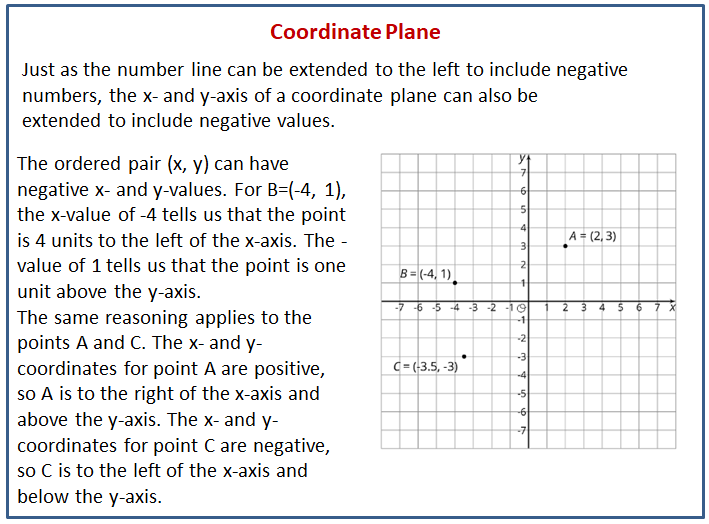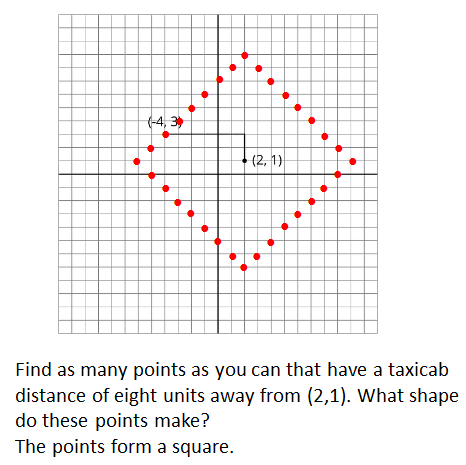Illustrative Mathematics Unit 6.7, Lesson 12: Constructing the Coordinate Plane
Learning Targets:
- When given points to plot, I can construct a coordinate plane with an appropriate scale and pair of axes.
Related Pages
Illustrative Math
Grade 6
Lesson 12: Constructing the Coordinate Plane
Let’s investigate different ways of creating a coordinate plane.
Illustrative Math Unit 6.7, Lesson 12 (printable worksheets)
Lesson 12 Summary
The coordinate plane can be used to show information involving pairs of numbers.
When using the coordinate plane, we should pay close attention to what each axis represents and what scale each uses.
The following diagram shows how to plot points on a coordinate plane that has four quadrants and negative coordinates

Lesson 12.1 English Winter
The following data were collected over one December afternoon in England.
- Which set of axes would you choose to represent these data? Explain your reasoning.
- Explain why the other two sets of axes did not seem as appropriate as the one you chose.
Scroll down the page for the solutions to the “Are you ready for more?” section.
Lesson 12.2 The Coordinate Plane
- Here are three sets of coordinates. For each set, draw and label an appropriate pair of axes and plot the points.
a. (1,2), (3,-4), (-5,-2), (0,2.5)
b. (50,50), (0,0), (-10,-30), (-35,40)
c. (1/4,3/4), (-5/4,1/2), (-1 1/4,-3/4) - Discuss with a partner:
- How are the axes and labels of your three drawings different?
- How did the coordinates affect the way you drew the axes and label the numbers?
Lesson 12.3 Positively A-maze-ing
Here is a maze on a coordinate plane. The black point in the center is (0, 0). The side of each grid square is 2 units long.
See Maze
- Enter the above maze at the location marked with a green segment. Draw line segments to show your way through and out of the maze. Label each turning point with a letter. Then, list all the letters and write their coordinates.
- Choose any 2 turning points that share the same line segment. What is the same about their coordinates? Explain why they share that feature.
Are you ready for more?
To get from the point (2,1) to (-4,3) you can go two units up and six units to the left, for a total distance of eight units. This is called the “taxicab distance,” because a taxi driver would have to drive eight blocks to get between those two points on a map.
Find as many points as you can that have a taxicab distance of eight units away from (2,1). What shape do these points make?
Lesson 12 Practice Problems
- Draw and label an appropriate pair of axes and plot the points.
(1/5,4/5)
(-3/5,2/5)
(-1 1/5, -4/5)
(1/5, -3/5) - Diego was asked to plot these points: (-50,0), (150,100), (200,-100), (350,50), (-250,0). What interval could he use for each axis? Explain your reasoning.
- a. Name 4 points that would form a square with the origin at its center.
b. Graph these points to check if they form a square. - Which of the following changes would you represent using a negative number? Explain what a positive number would represent in that situation.
a. A loss of 4 points
b. A gain of 50 yards
c. A loss of $10
d. An elevation above sea level - Jada is buying notebooks for school. The cost of each notebook is $1.75.
a. Write an equation that shows the cost of Jada’s notebooks, c, in terms of the number of notebooks, n, that she buys.
b. Which of the following could be points on the graph of your equation?
(1.75,1), (2.3,50), (5,8.75), (17.50,10), (9,15.35) - A corn field has an area of 28.6 acres. It requires about 15,000,000 gallons of water. About how many gallons of water per acre is that?
A. 5,000
B. 50,000
C. 500,000
D. 5,000,000
The Open Up Resources math curriculum is free to download from the Open Up Resources website and is also available from Illustrative Mathematics.
Try out our new and fun Fraction Concoction Game.
Add and subtract fractions to make exciting fraction concoctions following a recipe. There are four levels of difficulty: Easy, medium, hard and insane. Practice the basics of fraction addition and subtraction or challenge yourself with the insane level.

We welcome your feedback, comments and questions about this site or page. Please submit your feedback or enquiries via our Feedback page.
